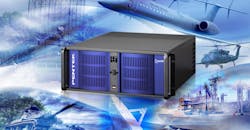Signal Recorder Integrates RF Tuner
A compact rack-mount solution for signal-intelligence (SIGINT) and communications-intelligence (COMINT) applications combines an intelligent scanning signal recorder with a wideband RF/microwave tuner. The RTR 2654 RF Sentinel Intelligent Signal Scanning system from Pentek automatically tunes the signal spectrum from 800 MHz to 26.5 GHz and records bandwidths as wide as 500 MHz using the Sentinel intelligent signal scanning software.
The combination tuner/recorder uses one of the company’s model 78141 Jade transceiver modules as the data acquisition subsystem. One of the transceiver’s dual 3.2-GSamples/s 12-b analog-to-digital converters (ADCs) is used at 2.8 GSamples/s for data conversion, coupled to the 500-MHz intermediate-frequency (IF) output of an RF/microwave tuner front end. A digital downconverter (DDC) provides frequency zooming in steps of 140, 280, and 500 MHz. “The RTR 2654 Sentinel recorder greatly expands the scanning spectrum over previous Pentek products to 26.5 GHz, covering the vast majority of popular RF signal bands,” said Rodger Hosking, vice-president of Pentek.
The compact rack-mount assembly simplifies automated signal monitoring and detection over its wide bandwidth, with coverage of any range (up to 500 MHz wide) from 800 MHz to 26.5 GHz. The frequency can be covered in consecutive bands, with the stop frequency of the previous sweep becoming the start frequency of the next sweep. A user can set any band for continuous real-time monitoring and recording, based on programmed signal strength threshold levels that trigger recordings of signals in the covered frequency range. The detected signals and recorded data can be used to create a waterfall spectrum display for each recording. Once a signal of interest is detected, the real-time recorder can capture and store hundreds of terabytes of data to disk, allowing users to store data spanning multiple days.
About the Author
Jack Browne
Technical Contributor
Jack Browne, Technical Contributor, has worked in technical publishing for over 30 years. He managed the content and production of three technical journals while at the American Institute of Physics, including Medical Physics and the Journal of Vacuum Science & Technology. He has been a Publisher and Editor for Penton Media, started the firm’s Wireless Symposium & Exhibition trade show in 1993, and currently serves as Technical Contributor for that company's Microwaves & RF magazine. Browne, who holds a BS in Mathematics from City College of New York and BA degrees in English and Philosophy from Fordham University, is a member of the IEEE.

